PA Bill Number: HB274
Title: In compensation, further providing for qualifications required to secure compensation and for ineligibility for compensation, providing for ...
Description: In compensation, further providing for qualifications required to secure compensation and for ineligibility for compensation, providing for ... ...
Last Action: Presented to the Governor
Last Action Date: Dec 18, 2025
DRGO: Public Health Gun Control: A Brief History (Special 3-part Report) :: 09/21/2015
In the wake of the Newtown, Connecticut school mass shooting, many have called for new restrictions on gun owners. The blood at Sandy Hook Elementary School wasn’t dry before mainstream media pundits, scheming politicians, and career gun control advocates began heaping condemnation and slander on American gun owners.
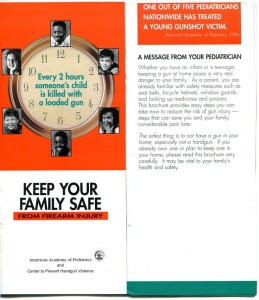
See the figure of a 1996 pamphlet jointly published by the American Academy of Pediatrics and the Center to Prevent Handgun Violence
Blaming innocent gun owners for the murderous actions of a few high-profile mass shooters is natural to them, since they blame guns for crime, rather than the humans who misuse them.
But one class of gun control advocate in particular has become vocal since Newtown. They had been silent for many years in the ongoing political assault on gun owners. In the weeks since Newtown we have seen a flurry of news articles from doctors and medical organizations (see this announcement from the American College of Physicians). They advocate a “public health approach” to the problem of “gun violence.” Most lay readers see these calls for more gun control as a fresh approach. Before Newtown the only public urging for gun control from medical researchers had been a few obscure medical journal articles, briefly covered by an always sympathetic mainstream media, but otherwise disappearing into the dust of the average news day. But as we shall reveal in this three-part series, the public health push for more gun control is not new at all.
The public health push for banning guns goes back to the late 1980s at least. In a 1989 issue of the Journal of the American Medical Association, Centers for Disease Control (CDC) official Patrick O’Carroll, MD stated “We’re going to systematically build a case that owning firearms causes deaths. We’re doing the most we can do, given the political realities.” (P.W. O’Carroll, Acting Section Head of Division of Injury Control, CDC, quoted in Marsha F. Goldsmith, “Epidemiologists Aim at New Target: Health Risk of Handgun Proliferation,” Journal of the American Medical Association vol. 261 no. 5, February 3, 1989, pp. 675-76.) The CDC’s anti-gun activism ran unabated until the mid-1990s. We shall discuss those events in Part II of this series.
These medical researchers insist that what they call “gun violence” is a public health problem. That they prefer the term “gun violence” is revealing of their mind set in approaching the problem, because it puts the emphasis on guns and not on the humans who misuse them. This misleading public health terminology, enthusiastically repeated by fellow gun control advocates in the mainstream media, ignores the fact that almost none of America’s 80 to 100 million gun owners have any role whatsoever in the misuse of guns. Normative gun ownership is foreign to most mainstream media personalities and to public health anti-gun rights advocates. They fear guns and gun owners, and they have no interest in learning about them or respecting their views. These prejudices and fears drive their campaign to bring ever more regulation to American gun owners.
It is for these reasons that public health gun control advocates typically say such reckless things as:
“Guns are a virus that must be eradicated.”—Dr. Katherine Christoffel, pediatrician, in American Medical News, January 3, 1994. In the 1990s Dr. Christoffel was the leader of the now-defunct HELP Network, a Chicago-based association of major medical organizations and grant seekers advancing gun control in the medical media. The name HELP was an acronym for Handgun Epidemic Lowering Plan.
“Data on [assault weapons’] risks are not needed, because they have no redeeming social value.—Jerome Kassirer, M.D., former editor, New England Journal of Medicine, writing in vol. 326, no. 17, page 1161 (April 23, 1992).
“I hate guns and I cannot imagine why anyone would want to own one. If I had my way, guns for sport would be registered, and all other guns would be banned.”—Assistant Dean Deborah Prothrow-Stith, M.D., Harvard School of Public Health in her book Deadly Consequences.
These astonishing public statements reveal how thin the veneer of reason can be, even in our supposed leading voices of science. When prejudice and emotion cloud their thinking, all their erudition can’t prevent the transformation of these worthies into raving ideologues. All three were made aware of the voluminous criminology literature that called into serious question their devotion to banning guns. The first two were offered several opportunities to at least read and rebut the criminology literature of the time, as well as to discuss gun policy rationally with their opponents. Neither bothered to debate the issues. Instead they dismissed our evidence out of hand. (See the figure of an American Medical News article about Dr. Christoffel)
Christoffel was also one of the original architects of the American Academy of Pediatrics’ (AAP) official policy on firearms, (this is the revised 2012 policy; the 1992 and 2000 versions are no longer available online) which advocates gun bans and urges doctors to use their patients’ trust to advance gun control. The AAP worked hand-in-hand with the Center to Prevent Handgun Violence, the “educational” and litigating arm of Handgun Control, Inc. These gun-ban lobby groups were rebranded in June 2001 to the less revealing titles of the Brady Center to Prevent Gun Violence and the Brady Campaign to Prevent Gun Violence, respectively. (See the figure of a 1996 pamphlet jointly published by the American Academy of Pediatrics and the Center to Prevent Handgun Violence)
During the 1990s the mainstream media and major medical organizations routinely discounted the already-large body of criminology evidence that supported private gun ownership as a social good. The California Medical Association (CMA) was one of several state AMA affiliates that jumped on the gun control bandwagon. This author was then a member of its House of Delegates, a supposedly democratic representative body responsible for formulating CMA policy. During debates at the CMA House of Delegates annual meeting I tried to present evidence from the real experts on gun crime, the criminologists. These studies, accepted in the academic world outside the public health gun control community, showed powerful social benefits from armed self-defense.
But my presentations were not allowed to be entered into the record of the debate. Three times I faxed information supportive of a pro-gun rights view to the CMA House of Delegates reference committee in charge of firearm issues. Three times my faxes were “lost.” It became clear to me that the California Medical Association was intolerant of honest debate. In fact, they suppressed any reasoned and documented testimony that contradicted their almost religious anti-gun rights campaign.
No true scientist would ever say “data are not needed” (see Kassirer quotation above) in any area of scientific investigation. Data are the building blocks of science, and reputable scientists follow the data wherever they lead. Dr. Kassirer and Dr. Christoffel made it clear during the gun control controversy of the 1990s that they had no interest at all in engaging the scientific issues. Their dismissive attitude was typical of almost all treatments of firearm issues in the medical literature of that time. And that contempt for science was their undoing.
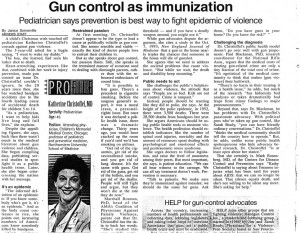
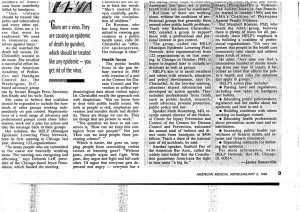
In Part I of this three-part series I laid out the background and general intentions of public health gun control activists in the early years of their campaign. In this part we relate the events that led to exposure of the Centers for Disease Control in its crucial roles. Those roles were the channeling of taxpayer money to public health academicians prominent in gun control advocacy research, and conducting its own campaign of taxpayer-funded gun control advocacy. An example of the latter is a CDC-funded newsletter published by the Trauma Foundation, a San Francisco gun control group.
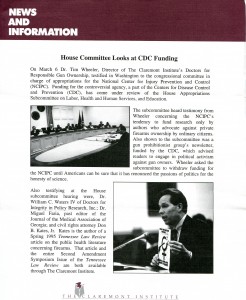
(PDF of Claremont News & Info)
Coincidentally, President Obama this week signed a gun banner’s wish list of executive actions he will take to advance gun control in the wake of the Sandy Hook school shooting in Newtown, Connecticut. One reads, “Issue a Presidential Memorandum directing the Centers for Disease Control to research the causes and prevention of gun violence.”
This is directed toward action that Congress took in the mid-1990s to remove $2.6 million from the CDC’s budget that would have gone toward more gun research. I will leave to my legal colleagues the question of whether a president can repeal a law passed by Congress. But it’s clear that gun control activists want to restart the federally funded gun control advocacy factory that was the CDC in the 1990s.
In Part I of this series we saw that a top CDC official in 1989 had announced, “We’re going to systematically build a case that owning firearms causes deaths. We’re doing the most we can do, given the political realities.” (P.W. O’Carroll, Acting Section Head of Division of Injury Control, CDC, quoted in Marsha F. Goldsmith, “Epidemiologists Aim at New Target: Health Risk of Handgun Proliferation,” Journal of the American Medical Association vol. 261 no. 5, February 3, 1989, pp. 675-76.) Dr. O’Carroll later said he had been misquoted and disavowed any pre-existing agenda. But his successor Dr. Mark Rosenberg was quoted in the Washington Post as wanting his agency to create a public perception of firearms as “dirty, deadly—and banned.” (William Raspberry, “Sick People With Guns,” Washington Post, October 19, 1994, quoted by Kates, et. al. in Tennessee Law Review article mentioned below). The preponderance of evidence points to a political agenda at the CDC.
By the early 1990s the CDC’s plan was well underway, as evidenced by a New England Journal of Medicine article whose lead author was Dr. Arthur Kellermann. Dr. Kellermann, eventually a recipient of over $1.7 million in CDC grant money, was a vocal supporter of gun control who was prominently quoted in the mainstream media. Those media outlets, the big city newspapers and major television news outlets of the time, were known then, as now, to share Kellermann’s view.
Dr. Kellermann’s article, “Gun Ownership as a Risk Factor for Homicide in the Home,” (New England Journal of Medicine vol. 329, no. 15, October 7, 1993) was supported by two grants from the CDC. The authors used a case-control method usually used in epidemiology research to investigate a criminology problem. Their conclusion, summarized as a factoid still quoted by gun control advocates to this day, was that people with a gun in the home are 2.7 times as likely to become homicide victims as people who don’t keep a gun in the home.
Gun control advocates and a sympathetic media cited Kellermann’s article endlessly, providing pseudoscientific justification for politicians looking for any reason to advance gun control. But the research methodology used by Kellermann and his coauthors was flawed. Aside from the unusual use of the case-control method more suited to epidemiology studies, the subjects for the study were highly aberrant. They were selected only from homicide victims in Shelby County, Tennessee; King County, Washington; and Cuyahoga County, Ohio. As the metropolitan areas including Memphis, Seattle, and Cleveland respectively, they were skewed toward inner city populations with high rates of violent crime.
The authors based their results entirely on people who had been murdered in their homes, a group wildly unrepresentative of gun owners in general. The authors themselves admit that half of the homicides occurred in connection with a “quarrel or romantic triangle” and 30 % occurred during the commission of drug dealing or another felony such as robbery, rape, or burglary. They made no attempt to consider the hundreds of thousands of responsible gun owners in the same geographical study areas who, like most gun owners, were not the type of people who commit violent felonies or become homicide victims.
Yet another flaw in this CDC-supported article was the authors’ failure to factor in the uses of guns in scaring off criminals. Fewer than 1% of all protective uses of firearms result in the death of the attacker. The article therefore underestimates the life-saving and injury-preventing utility of firearms kept at home.
Further weakening the article’s conclusions was the authors’ failure to show in even one case that the gun kept in the homicide victim’s home was the murder weapon. Establishing the use of that gun would be crucial to concluding that it was a hazard to the occupants, but whether by accidental omission or deliberate exclusion, the authors failed to show it.
Serious scientists in the field of criminology, who had studied gun crime for years, raised serious questions about Kellermann’s work and the work of other public health researchers. Their own research had often shown quite different results, generally affirming the utility of firearms as self-defense tools. Among these researchers were Florida State University criminologist Dr. Gary Kleck, urban studies expert Prof. Gary Mauser at Simon Fraser University, University of Massachusetts sociology professors James D. Wright and Peter H. Rossi, and later, Dr. John Lott who taught at the University of Chicago when he published a seminal article in the Journal of Legal Studies. Dr. Lott’s article showed that states that allowed law-abiding citizens to carry firearms for self-defense experienced a drop in violent crime.
The most revealing exposure of the public health anti-gun rights agenda was a comprehensive review by one of my fellow congressional witnesses (see below), criminologist and constitutional law expert Don Kates and several coauthors (“Guns and Public Health: Epidemic of Violence, or Pandemic of Propaganda?” Tennessee Law Review vol. 62 no. 3, Spring 1995). Kates et. al. provided a comprehensive record of the prejudice of public health anti-gun researchers that proved a turning point in the debate.
As the scientific process of peer scrutiny unfolded, it became clear that Kellermann’s work had little or no validity. His close connection with the already-outed CDC further discredited him. His research, like that of other public health advocacy researchers, came to be discounted by the scientific community except for a small group of public health anti-gun researchers.
The radical deviation of public health research on guns from mainstream criminology research attracted the attention of the National Rifle Association, a citizen-based group of American gun owners. These observers were rightfully concerned not only about the misuse of science to advance a political agenda of gun control, but also about the spending of millions of dollars of taxpayer money to do it. The NRA asked Congress to address the problem. In March 1996 I was one of three medical doctors and a criminologist who testified before the House of Representatives Appropriation Committee. We informed the committee of the CDC’s misuse of its authority and of federal funds to advance a plainly political agenda of gun control based on bad science.
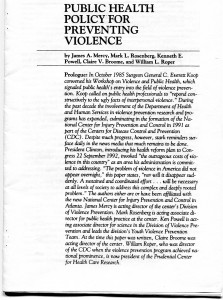
An example of the CDC’s insular approach to firearm research was a question posed in a winter 1993 CDC publication, Public Health Policy for Preventing Violence, by James A. Mercy, Mark L. Rosenberg, and others. Rosenberg was later to become the director of the CDC’s National Center for Injury Prevention and Control (NCIPC), the branch responsible for gun research. In this publication the authors seek an answer to the question “How frequently are guns used to successfully ward off potentially violent attacks?” To quote from my written testimony submitted to the House Appropriations Committee:
“A university criminologist in a position of responsibility similar to the NCIPC director would at least have known that this question has been exhaustively researched and answered by criminologists. Researchers in criminology, the real experts in the study of crime, have done at least eight independent studies of this question over the last twenty years. The best estimates consistently put the answer between 600,000 and 900,000 defensive uses of firearms every year. (Note: subsequent research yielded even higher estimates). We have to wonder why the authors, who by their titles could be considered front-line experts in the field, would not know of the relevant criminology literature on the subject.
In the same publication the authors recommend two strategies for preventing firearm injuries: allowing only police, guards, and the military to have guns, or the outright prohibition of gun ownership.”
But the more damning evidence of the CDC’s abuse of its authority had to do not with faulty science, but the intent behind its production. Dr. Rosenberg was quoted in a Rolling Stone magazine interview in the December 9, 1993 issue. He stated that he “envisions a long term campaign, similar to tobacco use and auto safety, to convince Americans that guns are, first and foremost, a public health menace.”
The reality is that most Americans consider owning guns to be not a public health menace, but a constitutionally protected right. It is part of their heritage. Rosenberg clearly had no understanding of the American mind on this subject 19 years ago. This quotation of his from the Connecticut Post in a January 14, 2013 article indicates he has learned nothing in the intervening years: “A more respectful attitude that views guns as dangerous and potentially lethal weapons—and not as cool, sexy, and macho glamour symbols—would help to promote public safety.”
Rosenberg really thinks American gun owners view their firearms as “cool, sexy, and macho glamour symbols”? This revealing statement typifies the attitude of urban elites toward a subject about which they are woefully ignorant. They see guns as evil talismans with no social utility whatsoever. And they clearly are not interested in learning about the long and ingrained American tradition of responsible gun ownership.
Finally, the most dramatic evidence of the CDC’s anti-gun rights agenda was the Injury Prevention Network Newsletter mentioned near the beginning of this article. This newsletter exhorted readers to “organize a picket at gun manufacturing sites” and to “work for campaign finance reform to weaken the gun lobby’s political clout.” And on the same page where the editor slanders gun owners by implicating them in the Oklahoma City federal building bombing, the following words appear: “This newsletter was supported in part by Grant #R49/CCR903697-06 from the Centers for Disease Control and Prevention.” (Note: under pressure the CDC requested a refund of the grant money. But its sympathy with a radical gun prohibition group had already been put on record).

(Trauma Foundation Newsletter)
And with today’s executive actions President Obama calculates that we have forgotten why our elected representatives put a stop to gun control advocacy at the Centers for Disease Control. His dedicated friends in the media have done their best to erase this bit of history. It is the job of American gun owners to be aware of the real history in all its details, the better to hold accountable those bureaucrats who now want to try once again to use our own money to campaign for the elimination of our gun rights.
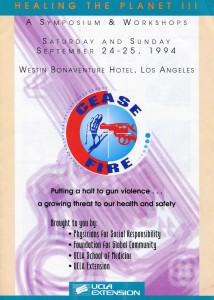
In Part I and Part II of this three-part series we described the political movement of organized medicine and public health activists to advance gun control during the 1990s and into the 2000s. During the first decade of the new century public reaction blunted the public health gun control push. In this part we will show that the medical gun prohibitionists are enjoying a resurgence of publicity provided by a sympathetic and generally anti-gun media. This is largely the result of high-profile mass shootings in 2012, pent-up motivation of frustrated gun control activists, and a president with a long record of working against gun owners’ rights.
Gun control advocates finally see an opportunity, denied them during the last decade, to once again push for gun control in government and in the public arena. Very few of their methods are new. Senator Dianne Feinstein has introduced a bill to once again outlaw modern sporting rifles, a repeat of the 1994 ban on so-called “assault weapons.” That law expired in 2004, never having been shown to reduce crime. California Rep. Adam Schiff (D-Burbank) this week introduced legislation to repeal the Protection of Lawful Commerce in Arms Act, enacted in 2005 to stop abusive litigation against gun manufacturers and dealers (see my 2003 National Review Online article about this). These are efforts to turn back the calendar, to repeal advances in the civil right of firearm ownership over the last decade.
Similarly, the public health gun prohibitionists are using the same arguments, almost word for word, that they advanced in the 1990s to try to convince the public that gun safety, and not gun prohibition, is their goal. After the December 14, 2012 mass shooting at Sandy Hook Elementary School in Newtown, Connecticut a flood of opinion articles appeared in large and small media outlets across the country. They all parroted the talking points of the 1990s public health gun controllers, urging policy makers to view “gun violence” as a public health problem rather than as a gun control debate. (Note: the term “gun violence” is itself a conscious effort at diverting the public from dealing with crime and instead scrutinizing law-abiding gun owners). This public relations scheme had its origins in 1990s activists who saw that they were beginning to lose the political debate over gun rights. They sought to redefine the terms of discussion, or to “reframe the debate,” to use their favorite term of obfuscation.
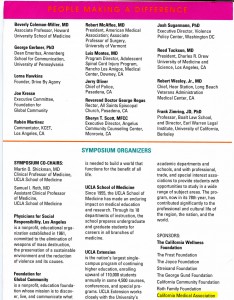
The flurry of articles from gun control activists advocating a public health view of “gun violence” are a step back in time. None of the authors bother to tell their readers that the “public health” approach was tried and failed miserably. And although these authors complain bitterly about Congress taking away federal funding of gun research at the Centers for Disease Control in 1997, none of them bother to tell their readers why Congress did it (see Part II of this series). These journalists apparently see no obligation to report the embarrassing truth, that the CDC was using that tax money to lobby for gun control.
Running through most of these articles is a common thread that because of Congress’s mandate that federal tax money not be used to fund gun control advocacy, there is a shortage of research on ways to reduce “gun violence.” They routinely demonize the National Rifle Association, accusing them of suppressing research that would help us find a solution to misuse of firearms. Former CDC official Dr. Mark Rosenberg even accused the NRA in a supposedly straight news piece of “terrorizing the CDC and the research community.” These biased journalists ignore the fact that the NRA spends millions of dollars and many hours of volunteers’ time in educating the public about firearm safety and legal use.
But more to the point, this complaint is just another deception from gun prohibitionists and their sympathizers in the media. Criminologists, not medical doctors, are the real experts on gun crime. And the body of scholarly firearm research done by criminologists dwarfs the research done by medical anti-gun advocacy researchers. Here is a short list of major firearm research projects from the criminology literature:
1) Wright, James D. and Rossi, Peter H. Armed and Considered Dangerous: A Survey of Felons and Their Firearms, Aldine de Gruyter, Hawthorne NY 1986. This 247-page hardbound book was the analysis of extensive data collected from over 2,000 convicted felons in American state prisons. Funded by the National Institute of Justice, this massive and comprehensive study found numerous truths about violent criminals that fly in the face of gun control advocates:
a) Felons prefer large, well-made handguns as tools of their trade, not “Saturday Night Specials” or rifles of any kind. (page 180)
b) The people most likely to be deterred from getting a handgun by gun bans are not criminals, but poor people who have decided they need a gun to protect themselves against the criminals. (page 238)
2) Lizotte, Alan A. “The Costs of Using Gun Control to Reduce Homicide,” Bulletin of the New York Academy of Medicine, vol. 62 no. 5 (June 1986), pp. 539-49. Criminologist Dr. Lizotte, now the dean of the School of Criminal Justice, University at Albany (SUNY), brings before a scientific panel the novel idea that, like any policy, gun control has costs.
3) Kleck, Gary Point Blank: Guns and Violence in America, Aldine de Gruyter, Hawthorne NY 1991. This 512-page book won the 1993 Michael J. Hindelang award of the American Society of Criminology. It offers analysis of the relationships between gun ownership, violent crime, and self-defense. His findings show that the average killer has a long history of criminal conduct, contrary to fashionable public health notions that anyone with a gun is a potential killer. He further found that most successful defensive gun uses are never reported to the police, the so-called “police chief’s fallacy.”
4) Kates, Don B., Schaffer, Henry E., Lattimer, John K., Murray, George B., and Cassem, Edwin W. “Guns and Public Health: Epidemic of Violence or Pandemic of Propaganda?” Tennessee Law Review vol. 62 no. 3 (Spring 1995). A criminologist, a genetics and biomathematics professor, a Columbia Medical School professor, and two Harvard Medical School professors of psychiatry analyze the public health literature on firearms. They find numerous examples of bias, prejudice against gun owners, and just plain ignorance among prominent public health gun researchers.
4) Kleck, Gary and Gertz, Marc “Armed Resistance to Crime: The Prevalence and Nature of Self-Defense With a Gun,” Journal of Criminal Law and Criminology vol. 86 no. 1 (Fall 1995). These two authors report the results of their large national telephone survey investigating defensive use of firearms. They found that “each year in the U.S. there are about 2.2 to 2.5 million DGUs [defensive gun uses] of all types by civilians against humans, with about 1.5 to 1.9 million of the incidents involving use of handguns.” (page 164)
5) Lott, John R. and Mustard, David B. “Crime, Deterrence, and Right-to-Carry Concealed Handguns,” Journal of Legal Studies vol. XXVI no. 1 (January 1997), University of Chicago Press. These authors studied violent crime trends over 15 years using county-level data from all 3,054 counties in the United States. They found that when state concealed handgun laws went into effect, murders, rapes, and aggravated assaults subsequently decreased.
6) Lott, John R. More Guns, Less Crime: Understanding Crime and Gun Control Laws, University of Chicago Press, Chicago 1998. This landmark book, based on Lott’s research referenced in the 1997 Journal of Legal Studies article, is now in its third edition, with analysis of new data.
7) Wellford, Charles F., Pepper, John V., and Petrie, Carol V., editors. Firearms and Violence: A Critical Review, Committee to Improve Research Information and Data on Firearms, Committee on Law and Justice, Division of Behavioral and Social Sciences and Education, National Research Council, The National Academies Press, Washington, DC (2005). This National Academies of Science committee of leading scholars in criminology reviewed all the existing research on homicide, suicide, and firearms. They found that the existing research studies “do not credibly demonstrate a causal relationship between the ownership of firearms and the causes or prevention of criminal violence or suicide.” I sat on guest panel as a discussant of the findings. Their review was published in this 328-page book.
8) Mauser, Gary A., “Evaluating Canada’s 1995 Firearm Legislation,” Journal on Firearms and Public Policy vol. 17 (Fall 2005), Center for the Study of Firearms and Public Policy of the Second Amendment Foundation, Bellevue, Washington. Professor Mauser (Institute for Urban Canadian Research Studies at Simon Fraser University in Burnaby, British Columbia) examines Canada’s controversial and costly 1995 Firearms Act. This unpopular law vastly exceeded initial dollar cost estimates and has never been definitively shown to have reduced crime. The part of the law requiring registration of long guns (rifles and shotguns) encountered such widespread resistance that it was finally repealed in 2012.
These examples are a short list of the more comprehensive works of criminology research on firearms. They all cite page upon page of references from other criminologists in a well-established body of publications on a thoroughly studied subject going back several decades. It is remarkable, then, that today’s public health gun advocacy researchers and their media supporters behave as though they don’t exist.
Of course, the public health researchers are aware of the criminology research on guns. There is only one reason they do not acknowledge it and sometimes even try to suppress it—in most cases the criminology research disproves every gun control talking point the public health gun control advocacy researchers promote to us. Instead of violent crime being potentially committed by anyone who owns a gun, it is the work of a very small, very abnormal subset of the population. Instead of guns in citizens’ hands causing more crime, they prevent crime because of their deterrent effect on criminals. And fatal firearm accidents are not increasing; they are steadily decreasing despite great increases in the population and in the number of gun owners.
But the public health gun control advocates have done worse than just willfully ignoring the truth. Dr. John Lott, whose works are referenced above, was the target of unbelievable prejudice and hostility when he published his groundbreaking book “More Guns, Less Crime.” Susan Glick of the gun confiscation advocacy group the Violence Policy Center at first refused his request for review of the study, saying she didn’t want to give it more publicity. But when the big story broke anyway, Ms. Glick attacked the study in an ABC News interview as “flawed,” even though she had not read the study.
The Johns Hopkins University Center for Gun Policy and Research wrote critical letters to the editors of dozens of newspapers around the country. Hopkins researchers were unable to challenge Lott on the scientific merits, but that didn’t stop them from smearing him.
A book review published in the famously anti-gun New England Journal of Medicine compared Dr. Lott to Archie Bunker, the archetypal TV-land bigot.
The California Medical Association, long a supporter of gun control (see UCLA symposium brochure), has a large body of policy supporting various gun control measures. They insist their anti-gun rights policy is science-based, but in policy sessions they refused to even consider Dr. Lott’s book or any of the other major works cited above. They have an anti-gun rights agenda, and they are not going to allow real science to interfere with it.
And so it continues. We can expect more of the same denial and suppression of debate from the public health gun controllers, because that is what they have done in the past. Our job is to break through their stone wall of suppression and to liberate the truth. And the truth is that the science proves responsible gun owners are not the cause of violent crime. They are the solution.



